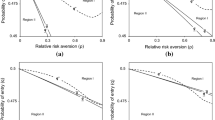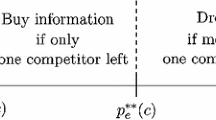Summary.
The paper analyzes a problem of optimal auction design when the seller faces asymmetrically informed bidders. Specifically, we consider a continuum of risk-neutral uninformed bidders taking part into the auction along with n risk-averse informed bidders. The contribution of the paper is threefold. First, we fully characterize the optimal auction in this non standard environment and in a very general set-up. We find that when informed bidders reveal “bad news” about the value of the good, the seller optimally awards the object to the uninformed bidders. Secondly, we show that the seller is better off in presence of uninformed bidders because this allows to lower the informational rents paid to the informed bidders. Last, we find that, with bi-lateral risk neutrality, the seller always awards the good to the uninformed bidders thereby keeping all the surplus.
Similar content being viewed by others
Author information
Authors and Affiliations
Corresponding author
Additional information
Received: 22 October 2004, Revised: 21 April 2005,
JEL Classification Numbers:
D44, D82.
We are very grateful to two anonymous referees, Jacques Crémer, Patrick François, Angel Hernando-Veciana and seminar participants at the 2004 SCSE conference (Quebec, Canada) for their valuable comments. Moez Bennouri acknowledges the financial support by the Initiative of the New Economy (INE) program of SSHRC (Canada).
Rights and permissions
About this article
Cite this article
Bennouri, M., Falconieri, S. Optimal auctions with asymmetrically informed bidders. Economic Theory 28, 585–602 (2006). https://doi.org/10.1007/s00199-005-0637-2
Issue Date:
DOI: https://doi.org/10.1007/s00199-005-0637-2




